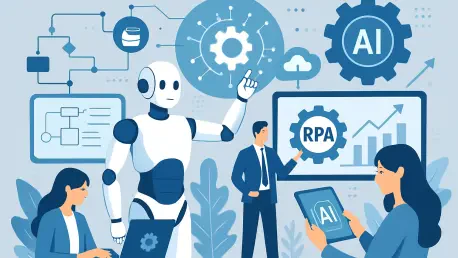In an era where business landscapes shift at breakneck speed, organizations are under constant pressure to innovate, streamline operations, and outpace competitors. Enter hyperautomation—a transformative approach that fuses the mechanical efficiency of Robotic Process Automation (RPA) with the cognitive brilliance of Artificial Intelligence (AI). This powerful synergy moves far beyond the limitations of traditional automation, which often focuses solely on repetitive, rule-based tasks. Instead, hyperautomation equips systems to execute processes, analyze data, adapt to changes, and continuously refine workflows with minimal human intervention. It’s not just a tool but a strategic overhaul, enabling companies to achieve unprecedented levels of efficiency while fostering innovation in a fiercely competitive market. As industries grapple with digital transformation, this technology stands out as a beacon for scalability and resilience, promising to redefine how work is approached across sectors.
Unpacking the Concept and Evolution
Hyperautomation represents a significant leap forward from the foundational principles of RPA, which primarily automates structured, repetitive tasks such as data entry or invoice processing. By integrating AI technologies like machine learning and natural language processing, it transcends these boundaries to tackle complex, unstructured data and dynamic environments. Where RPA falters in the face of ambiguity or change, hyperautomation shines by embedding decision-making capabilities and self-learning mechanisms into workflows. This evolution signals a broader shift in business operations—from merely automating isolated tasks to creating intelligent systems that mimic human reasoning and adaptability. The result is a framework that not only executes predefined actions but also evolves over time, optimizing processes in ways that were previously unimaginable for traditional automation tools.
This progression has been driven by the growing need for businesses to handle vast amounts of data and respond swiftly to market fluctuations. Hyperautomation addresses these demands by offering a holistic solution that integrates multiple technologies into a cohesive strategy. Unlike earlier automation efforts that often operated in silos, this approach connects disparate systems, enabling seamless communication and coordination across departments. It’s a response to the complexities of modern enterprises, where siloed processes can hinder growth and responsiveness. By building on RPA’s strengths and augmenting them with AI’s analytical power, hyperautomation lays the groundwork for end-to-end process improvement, positioning itself as a critical asset for organizations aiming to stay agile in an unpredictable landscape.
Core Technologies Powering the Shift
At the core of hyperautomation lie several innovative components that work in tandem to deliver intelligent automation. Process discovery, for instance, employs advanced tools like process mining to map out existing workflows, revealing inefficiencies and bottlenecks that might otherwise go unnoticed. This capability often extends to creating digital twins of organizations—virtual replicas that allow leaders to simulate and refine operations before implementation. Similarly, intelligent document processing (IDP) harnesses AI-driven optical character recognition and natural language processing to convert unstructured data from sources like emails or scanned documents into structured, actionable insights. These tools form the backbone of hyperautomation, ensuring that even the most chaotic information can be tamed and utilized effectively across business functions.
Beyond data handling, hyperautomation leverages adaptive smart bots and low-code platforms to enhance flexibility and accessibility. Smart bots are designed to visually interpret interfaces and adjust to changes in real-time, eliminating the need for constant reprogramming when systems update. Meanwhile, low-code platforms democratize automation by enabling non-technical employees to design workflows using intuitive, plain-language interfaces. This reduces dependency on specialized IT teams and fosters a culture of innovation throughout the organization. Additionally, continuous feedback loops allow systems to self-monitor and learn from human inputs, refining processes to minimize errors and maximize efficiency. Together, these components create a robust ecosystem where automation isn’t just a technical solution but a collaborative, evolving strategy.
Transforming Industries with Real-World Applications
Hyperautomation is making waves across diverse sectors, proving its versatility in addressing industry-specific challenges. In banking and finance, it accelerates critical processes like loan approvals and fraud detection by automating data analysis and decision-making, while also ensuring compliance with stringent regulations. Healthcare organizations benefit from reduced administrative burdens, as tasks like patient scheduling and billing are streamlined, freeing up staff to prioritize direct patient care. These applications demonstrate how hyperautomation can transform operational efficiency, allowing industries to redirect resources toward core objectives rather than getting bogged down by routine work. The impact is tangible, with measurable improvements in speed and accuracy.
In retail and e-commerce, hyperautomation provides the agility needed to respond to fluctuating market demands while keeping costs in check. Automated inventory management and customer service workflows enable businesses to scale operations without sacrificing quality. Similarly, in expense management, real-time validation and policy enforcement help curb fraudulent claims, enhancing transparency and accountability. These examples underscore a common theme: hyperautomation doesn’t just optimize processes—it empowers organizations to focus on strategic growth and customer satisfaction. By addressing pain points unique to each sector, it creates tailored solutions that drive both immediate results and long-term resilience, cementing its role as a catalyst for industry-wide transformation.
Advantages That Redefine Business Outcomes
The benefits of hyperautomation extend well beyond the obvious gains in speed and operational efficiency. One of its most compelling advantages is adaptability, allowing businesses to pivot swiftly in response to unexpected disruptions or evolving market conditions. This flexibility is crucial in a world where change is the only constant, ensuring that organizations remain competitive even under pressure. Moreover, hyperautomation enhances scalability by creating systems that can handle increased workloads without proportional increases in cost or complexity. This capability is particularly valuable for growing enterprises that need to expand operations without overhauling their infrastructure, providing a sustainable path to growth.
Equally significant is the human-centric focus that hyperautomation introduces. By automating repetitive, mundane tasks, it liberates employees to engage in more creative and strategic endeavors, fostering a sense of purpose and satisfaction in their roles. This shift not only boosts individual productivity but also cultivates an environment where innovation thrives. Employees can dedicate their energy to solving complex problems or developing new ideas, while automated systems handle the grunt work. The result is a workforce that feels empowered rather than replaced, aligning technological advancement with human potential. Such outcomes highlight how hyperautomation redefines success, measuring it not just in numbers but in the quality of work and employee engagement.
Navigating the Roadblocks to Implementation
Despite its transformative potential, adopting hyperautomation comes with a set of challenges that organizations must address to ensure success. Integration complexity stands out as a primary hurdle, particularly when aligning AI and RPA with legacy systems that were not designed for such advanced technologies. These incompatibilities can lead to significant costs and delays if not managed with foresight. Additionally, the technical demands of maintaining hyperautomation systems—such as updating AI models to reflect new data or retraining bots to adapt to process changes—require consistent attention and resources. Without a clear plan, these ongoing needs can strain budgets and operational focus.
Cultural and skill-based obstacles also pose significant barriers. Change management becomes critical as employees may harbor skepticism or resistance toward automated decision-making, fearing job displacement or loss of control. Addressing these concerns demands transparent communication and robust training programs to build trust in the technology. Furthermore, a notable talent gap exists in the realm of AI and process design expertise, with many organizations struggling to find professionals who can effectively deploy and manage hyperautomation initiatives. Overcoming these challenges requires a combination of strategic leadership, investment in upskilling, and a commitment to fostering a culture that embraces technological change rather than resists it.
Envisioning Tomorrow’s Intelligent Workflows
Looking to the horizon, hyperautomation is poised to transition from reactive solutions to proactive, predictive systems that anticipate challenges before they emerge. Imagine workflows that not only respond to current demands but also forecast potential issues, reallocating resources to prevent disruptions. This forward-thinking approach could redefine operational resilience, giving businesses a competitive edge in volatile markets. Integration with generative AI adds another layer of potential, enabling capabilities like autonomous document drafting or contract negotiation—tasks that push the boundaries of what automation can achieve. Such advancements signal a future where hyperautomation becomes the backbone of business strategy.
The path forward also emphasizes continuous improvement and intelligent orchestration. As systems grow smarter, they will likely incorporate tighter feedback loops, learning from every interaction to refine processes with minimal human oversight. This evolution promises to make hyperautomation a cornerstone of organizational agility, especially for those navigating complex, data-driven environments. While the journey to fully proactive systems is still unfolding, the groundwork laid today suggests a landscape where technology and human ingenuity collaborate seamlessly, driving innovation at every level. The focus now lies in strategic adoption and sustained refinement to unlock these possibilities.









